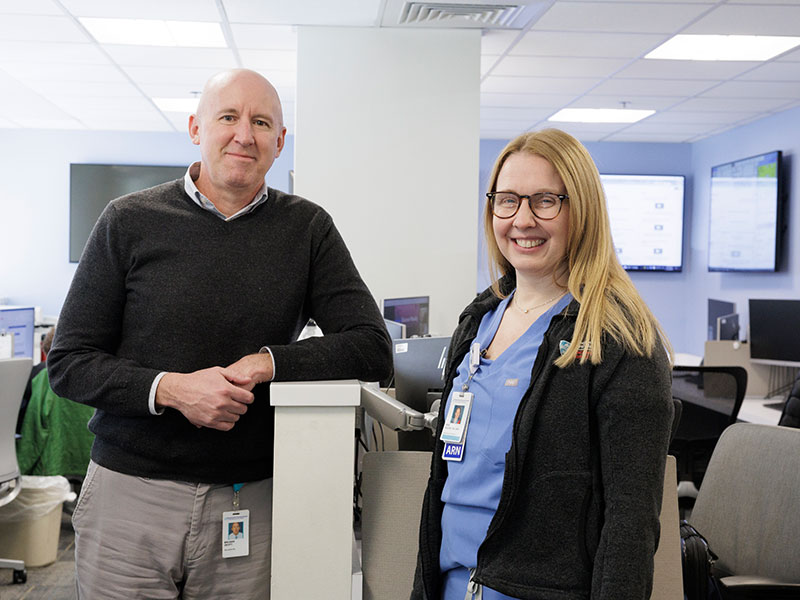Connect to Capacity: Treating Patients and Colleagues As Family
Alysia Monaco, AGACNP-BC of MGH Cardiac Surgery, discusses treating patients and colleagues like family.
News4 Minute ReadApr | 10 | 2024

With more than 30,000 people working at MGH and the role technology plays in the hospital, it is no surprise some co-workers never meet face-to-face. This was the case for Erin Hachey, RN, of Bigelow 11, and Ben Orcutt, director of MGH Patient Access Services. Hachey and Orcutt work together daily to mitigate capacity challenges, yet they typically only communicate through an app called Voalte.
“The tool is a great way to communicate because, as nurses, we’re on the go and are not sitting at a desk,” says Hachey. “The app helps with efficiency; I can send a message on my phone from anywhere. The teammate on the other end receives the message instantly.”
Hachey spends a significant part of her day working to increase capacity – which is especially important on Bigelow 11, she says, because some patients there experience lengthy stays.
“Some patients have neurocognitive declines and may be in the process of going under legal guardianship and that takes time to get through the system,” Hachey says. “Others with substance use disorders may be waiting for a bed at an in-patient recovery center. With so many variables, it’s important to do what we can to ensure MGH beds are available for those who acutely need them.”
For Hachey, that means adopting new workflows to address capacity challenges on her floor.
“It’s all about understanding the barriers to discharge,” she says.
For instance: A newly diagnosed diabetic needs insulin training before they go home. Or, someone with heart problems is now on blood thinners and needs to be educated about the risks. Hachey steps in to do much of the teaching. That way, she says, the bedside nurse can focus on bedside care and the discharge process can move along seamlessly.
Other times, a patient may be waiting for something a nurse cannot provide. That is when Hachey texts Orcutt, who often can help address issues and expedite necessary testing so a patient can safely go home sooner. The process is part of a pilot program aimed at improving throughput to help alleviate capacity challenges.
“Maybe a patient needs an MRI,” Hachey says. “In the past, we may have just waited for the MRI. Or- I would have called imaging trying to get an ETA, or if the wait could be sped up. A bedside nurse may have done the same thing. Now, it’s one call to Ben. This process saves us so much time and energy that we can put back into patient care- while helping free a bed for a new acute patient. It’s a total win.”
The pilot program has proven so successful it has now been implemented on other hospital floors.
Hachey and Orcutt each said it felt strange to work together so often and never to have met. In early March that changed. The two finally met face-to-face to thank each other for helping to improve the care of MGH patients.
“I’m so glad to finally meet Ben and thrilled to thank him for his support. It’s long overdue!” says Hachey. “We have excellent communication and work as a team, and that’s critical in combatting capacity challenges.”
Adds Orcutt, “I’m a non-clinical person but I want to contribute to the care at MGH. I can do it by helping move things along. It’s instant gratification, too. I move an MRI up and in turn, a patient gets to go home to their family. It’s a fulfilling job, and I work with great people like Erin.”
Alysia Monaco, AGACNP-BC of MGH Cardiac Surgery, discusses treating patients and colleagues like family.
Amber Moore, MD, director of Inpatient Medicine in the Department of Medicine, is working to improve the process of patients seeking to transfer in from other care facilities.
Malinda Buck, a patient access bed manager supervisor in the MGH Capacity Center, is determined to get patients where they need to be: in rooms, healing, and then going home.